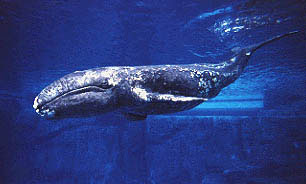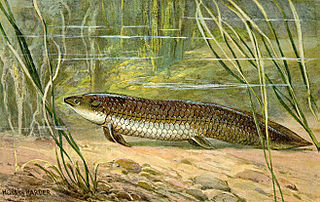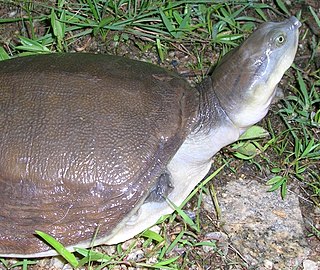
Eschrichtiidae or the gray whales is a family of baleen whale with a single extant species, the gray whale, as well as three described fossil genera: Archaeschrichtius and Eschrichtioides from the Miocene and Pliocene of Italy respectively, and Gricetoides from the Pliocene of North Carolina. More recent phylogenetic studies have found this family to be invalid, with its members nesting inside the Balaenopteridae. The names of the extant genus and the family honours Danish zoologist Daniel Eschricht.

Balaenoptera is a genus of rorquals containing eight extant species. Balaenoptera comprises all but two of the extant species in its family ; the genus is currently polyphyletic, with the two aforementioned species being phylogenetically nested within it.

Ceratodontidae is an extinct family of lungfish with fossils known from the earliest Triassic to the Eocene.

Lissemys is a genus of softshell turtles in the subfamily Cyclanorbinae of the family Trionychidae. The genus is indigenous to southern Asia.

Cyatholipidae is a family of spiders first described by Eugène Simon in 1894. Most live in moist montane forest, though several species, including Scharffia rossi, live in dry savannah regions. They occur in Africa, including Madagascar, New Zealand and Australia, and one species in Jamaica. Most members of this family hang beneath sheet webs. Fossil species occur in the Eocene aged Bitterfield and Baltic Ambers, suggesting a wider geographic distribution in the past.

Cycloderma is a genus of softshell turtles in the subfamily Cyclanorbinae of the family Trionychidae. The genus is endemic to Africa.
Hyposaurus is a genus of extinct marine dyrosaurid crocodyliform. Fossils have been found in Paleocene aged rocks of the Iullemmeden Basin in West Africa, Campanian–Maastrichtian Shendi Formation of Sudan and Maastrichtian through Danian strata in New Jersey, Alabama and South Carolina. Isolated teeth comparable to Hyposaurus have also been found in Thanetian strata of Virginia. It was related to Dyrosaurus. The priority of the species H. rogersii has been debated, however there is no sound basis for the recognition of more than one species from North America. The other North American species are therefore considered nomina vanum.

Campylocephalus is a genus of eurypterid, a group of extinct aquatic arthropods. Fossils of Campylocephalus have been discovered in deposits ranging from the Carboniferous period in the Czech Republic to the Permian period of Russia. The generic name is composed of the Greek words καμπύλος (kampýlos), meaning "curved", and κεφαλή (kephalē), meaning "head".
Metaceratodus is an extinct genus of prehistoric lungfish in the family Ceratodontidae, with an indeterminate specimen known from the Late Triassic (Norian)-aged Lissauer Breccia of Poland and more complete specimens known from the Late Cretaceous of Queensland, Australia and Argentina. The genus was named and described by Frederick Chapman in 1914.

The Scalopinae, or New World moles, are one of three subfamilies of the family Talpidae, which consists of moles and mole-like animals; the other two subfamilies being the Old World talpids and the Chinese shrew-like moles (Uropsilinae). The Scalopinae are the only Talpidae subfamily to consist entirely of undisputed moles and no mole-like close relatives such as shrew-moles or desmans.

Baenidae is an extinct family of paracryptodiran turtles known from the Early Cretaceous to Eocene of North America. While during the Early Cretaceous they are found across North America, during the Late Cretaceous they are only found in Laramidia, having disappeared from Appalachia. The majority of lineages survived the K-Pg Extinction, but the family was extinct by the latest Eocene. The name of the type genus, Baena, appears to be of Native American origin. They are primarily found in freshwater deposits, and are considered to be aquatic, with a largely generalist habit.
Muiscasaurus is an extinct genus of ophthalmosaurid Ichthyosaur that lived in modern Colombia during the Early Cretaceous. The only known species is the type Muiscasaurus catheti.

Idiorophus is a genus of toothed whales in the family Physeteridae. Fossils have been found in the Colhuehuapian Gaiman Formation of Argentina and the Libano Sandstone in Italy.

Boreostemma is an extinct genus of glyptodonts from northern South America. Fossils assigned to the genus were first described as belonging to Asterostemma from southern South America, but have been placed in the new genus Boreostemma by Carlini et al. in 2008. The type species is B. pliocena. Fossils of Boreostemma have been found in the Honda Group of Colombia, in Peru and Venezuela.

Miocochilius is an extinct genus of small notoungulate mammals (typotheres) native to South America. The genus lived during the Middle Miocene epoch. The genus contains two described species, the type species M. anomopodus described in 1953 by Ruben Arthur Stirton and M. federicoi, described and included in the genus by Darin A. Croft.
Canaanimico is an extinct genus of medium-sized New World monkeys from the Late Oligocene fossiliferous fluvio-lacustrine Chambira Formation of the Ucayali Basin in Amazonian Peru. The genus was described by Marivaux et al. in 2016 and the type species is C. amazonensis.
Labrostochelys is an extinct genus of bothremydid pleurodiran turtle that was discovered in the Ouled Abdoun Basin, Morocco. The genus consists solely of type species L. galkini.
Theroteinus is an extinct genus of haramiyidan mammaliaforms from the Late Triassic of France and Britain. It contains three species: T. nikolai,T. rosieriensis and T. jenkinsi, the former two of which are known exclusively from teeth found at the sand quarry of Saint-Nicolas-de-Port, while T. jenkinsi is known from a bedded sequence belonging to the Westbury Formation in a road cutting near Holwell, Dorset. Theroteinus is the only member of the family Theroteinidae and the suborder Theroteinida.
This page is based on this
Wikipedia article Text is available under the
CC BY-SA 4.0 license; additional terms may apply.
Images, videos and audio are available under their respective licenses.











